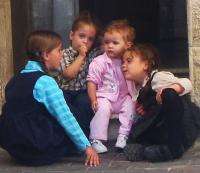January 7, 2014 report
Researchers find genetic link between number of children and grandchildren produced

(Medical Xpress)—A team of researchers at the University of Queensland, Australia has found a genetic link between the number of children people have and the number of children their offspring have. In their paper published in Proceedings of the National Academy of Sciences, the researchers report that in studying twins born between 1915 and 1929 and their offspring, they found a correlation between offspring and grand offspring numbers.
The researchers note the reproductive success (the number of children a person is capable of having) is commonly measured as a degree of fitness, rather than as a genetic predisposition. Their new study suggests, however, that the number of children a person is capable of producing may be limited also by their genetic makeup. If a person has five children, for example, the odds are, the researchers say, those five offspring will have near the same number (taking birth control out of the equation, of course) of children as their parents did and so will the grandchildren of the original person.
The team's results indicate there may be flaws in research that relies on degree of fitness in population studies based on genetic analysis, e.g. calculating historical population growth or rates.
To come to their conclusions, the researchers performed quantitative genetic analysis on data related to 16,268 Swedish twins (and their offspring) born between the years 1915 and 1929. After taking into account natural gender differences, birth control efforts and environment, they found that there was very little difference between the number of children the twins had and the number of children produced by their offspring. They also correlated the number of offspring of one twin with the grandchildren of the other twin and found the numbers matched more closely for the identical twins than for non-identical twins, suggesting a strong genetic link.
Their findings suggest that overall physical health and fitness are not the only factors involved when measuring reproductive success. Put another way, they contend that studies involving genetic change that use offspring quantity as a proxy for fitness may result in flawed numbers. They suggest that such studies in the future take into account genetic limitations by using lifetime reproductive success as a means of representing fitness.
More information: "Perfect genetic correlation between number of offspring and grandoffspring in an industrialized human population," by Brendan Paul Zietsch, Ralf Kuja-Halkola, Hasse Walum, and Karin J.H. Verwejj. PNAS, www.pnas.org/cgi/doi/10.1073/pnas.1310058111
Abstract
Reproductive success is widely used as a measure of fitness. However, offspring quantity may not reflect the genetic contribution to subsequent generations if there is nonrandom variation in offspring quality. Offspring quality is likely to be an important component of human fitness, and tradeoffs between offspring quantity and quality have been reported. As such, studies using offspring quantity as a proxy for fitness may yield erroneous projections of evolutionary change, for example if there is little or no genetic variance in number of grandoffspring or if its genetic variance is to some extent independent of the genetic variance in number of offspring. To address this, we performed a quantitative genetic analysis on the reproductive history of 16,268 Swedish twins born between 1915 and 1929 and their offspring. There was significant sex limitation in the sources of familial variation, but the magnitudes of the genetic and environmental effects were the same in males and females. We found significant genetic variation in number of offspring and grandoffspring (heritability = 24% and 16%, respectively), and genetic variation in the two variables completely overlapped—i.e., there was a perfect genetic correlation between number of offspring and grandoffspring. Shared environment played a smaller but significant role in number of offspring and grandoffspring; again, there was a perfect shared environmental correlation between the two variables. These findings support the use of lifetime reproductive success as a proxy for fitness in populations like the one used here, but we caution against generalizing this conclusion to other kinds of human societies.
© 2014 Medical Xpress


















